Dirk Groeneveld
OLMoTrace: Tracing Language Model Outputs Back to Trillions of Training Tokens
Apr 09, 2025Abstract:We present OLMoTrace, the first system that traces the outputs of language models back to their full, multi-trillion-token training data in real time. OLMoTrace finds and shows verbatim matches between segments of language model output and documents in the training text corpora. Powered by an extended version of infini-gram (Liu et al., 2024), our system returns tracing results within a few seconds. OLMoTrace can help users understand the behavior of language models through the lens of their training data. We showcase how it can be used to explore fact checking, hallucination, and the creativity of language models. OLMoTrace is publicly available and fully open-source.
2 OLMo 2 Furious
Dec 31, 2024
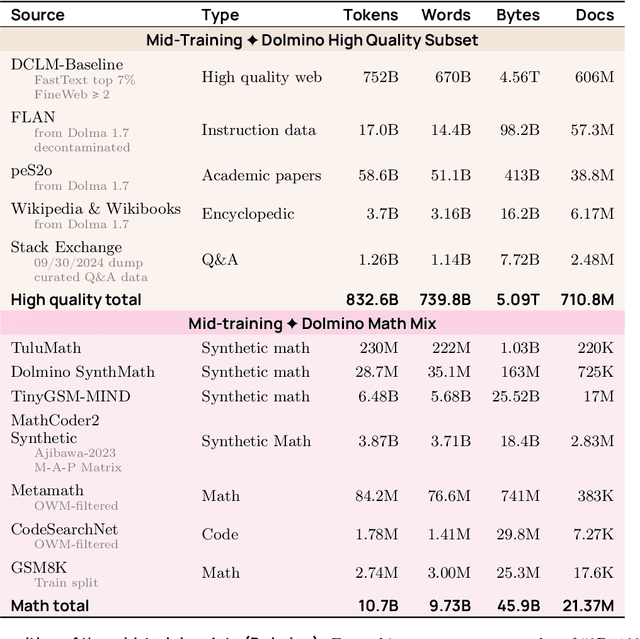
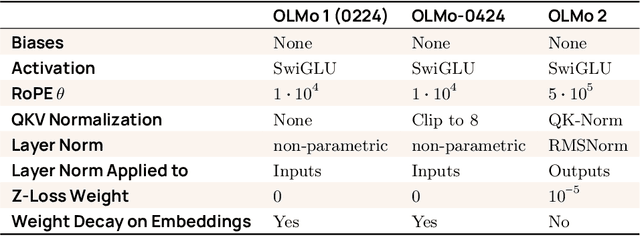

Abstract:We present OLMo 2, the next generation of our fully open language models. OLMo 2 includes dense autoregressive models with improved architecture and training recipe, pretraining data mixtures, and instruction tuning recipes. Our modified model architecture and training recipe achieve both better training stability and improved per-token efficiency. Our updated pretraining data mixture introduces a new, specialized data mix called Dolmino Mix 1124, which significantly improves model capabilities across many downstream task benchmarks when introduced via late-stage curriculum training (i.e. specialized data during the annealing phase of pretraining). Finally, we incorporate best practices from T\"ulu 3 to develop OLMo 2-Instruct, focusing on permissive data and extending our final-stage reinforcement learning with verifiable rewards (RLVR). Our OLMo 2 base models sit at the Pareto frontier of performance to compute, often matching or outperforming open-weight only models like Llama 3.1 and Qwen 2.5 while using fewer FLOPs and with fully transparent training data, code, and recipe. Our fully open OLMo 2-Instruct models are competitive with or surpassing open-weight only models of comparable size, including Qwen 2.5, Llama 3.1 and Gemma 2. We release all OLMo 2 artifacts openly -- models at 7B and 13B scales, both pretrained and post-trained, including their full training data, training code and recipes, training logs and thousands of intermediate checkpoints. The final instruction model is available on the Ai2 Playground as a free research demo.
Establishing Task Scaling Laws via Compute-Efficient Model Ladders
Dec 05, 2024Abstract:We develop task scaling laws and model ladders to predict the individual task performance of pretrained language models (LMs) in the overtrained setting. Standard power laws for language modeling loss cannot accurately model task performance. Therefore, we leverage a two-step prediction approach: first use model and data size to predict a task-specific loss, and then use this task loss to predict task performance. We train a set of small-scale "ladder" models, collect data points to fit the parameterized functions of the two prediction steps, and make predictions for two target models: a 7B model trained to 4T tokens and a 13B model trained to 5T tokens. Training the ladder models only costs 1% of the compute used for the target models. On four multiple-choice tasks written in ranked classification format, we can predict the accuracy of both target models within 2 points of absolute error. We have higher prediction error on four other tasks (average absolute error 6.9) and find that these are often tasks with higher variance in task metrics. We also find that using less compute to train fewer ladder models tends to deteriorate predictions. Finally, we empirically show that our design choices and the two-step approach lead to superior performance in establishing scaling laws.
Molmo and PixMo: Open Weights and Open Data for State-of-the-Art Multimodal Models
Sep 25, 2024



Abstract:Today's most advanced multimodal models remain proprietary. The strongest open-weight models rely heavily on synthetic data from proprietary VLMs to achieve good performance, effectively distilling these closed models into open ones. As a result, the community is still missing foundational knowledge about how to build performant VLMs from scratch. We present Molmo, a new family of VLMs that are state-of-the-art in their class of openness. Our key innovation is a novel, highly detailed image caption dataset collected entirely from human annotators using speech-based descriptions. To enable a wide array of user interactions, we also introduce a diverse dataset mixture for fine-tuning that includes in-the-wild Q&A and innovative 2D pointing data. The success of our approach relies on careful choices for the model architecture details, a well-tuned training pipeline, and, most critically, the quality of our newly collected datasets, all of which will be released. The best-in-class 72B model within the Molmo family not only outperforms others in the class of open weight and data models but also compares favorably against proprietary systems like GPT-4o, Claude 3.5, and Gemini 1.5 on both academic benchmarks and human evaluation. We will be releasing all of our model weights, captioning and fine-tuning data, and source code in the near future. Select model weights, inference code, and demo are available at https://molmo.allenai.org.
OLMoE: Open Mixture-of-Experts Language Models
Sep 03, 2024



Abstract:We introduce OLMoE, a fully open, state-of-the-art language model leveraging sparse Mixture-of-Experts (MoE). OLMoE-1B-7B has 7 billion (B) parameters but uses only 1B per input token. We pretrain it on 5 trillion tokens and further adapt it to create OLMoE-1B-7B-Instruct. Our models outperform all available models with similar active parameters, even surpassing larger ones like Llama2-13B-Chat and DeepSeekMoE-16B. We present various experiments on MoE training, analyze routing in our model showing high specialization, and open-source all aspects of our work: model weights, training data, code, and logs.
DataComp-LM: In search of the next generation of training sets for language models
Jun 18, 2024



Abstract:We introduce DataComp for Language Models (DCLM), a testbed for controlled dataset experiments with the goal of improving language models. As part of DCLM, we provide a standardized corpus of 240T tokens extracted from Common Crawl, effective pretraining recipes based on the OpenLM framework, and a broad suite of 53 downstream evaluations. Participants in the DCLM benchmark can experiment with data curation strategies such as deduplication, filtering, and data mixing at model scales ranging from 412M to 7B parameters. As a baseline for DCLM, we conduct extensive experiments and find that model-based filtering is key to assembling a high-quality training set. The resulting dataset, DCLM-Baseline enables training a 7B parameter language model from scratch to 64% 5-shot accuracy on MMLU with 2.6T training tokens. Compared to MAP-Neo, the previous state-of-the-art in open-data language models, DCLM-Baseline represents a 6.6 percentage point improvement on MMLU while being trained with 40% less compute. Our baseline model is also comparable to Mistral-7B-v0.3 and Llama 3 8B on MMLU (63% & 66%), and performs similarly on an average of 53 natural language understanding tasks while being trained with 6.6x less compute than Llama 3 8B. Our results highlight the importance of dataset design for training language models and offer a starting point for further research on data curation.
OLMo: Accelerating the Science of Language Models
Feb 07, 2024
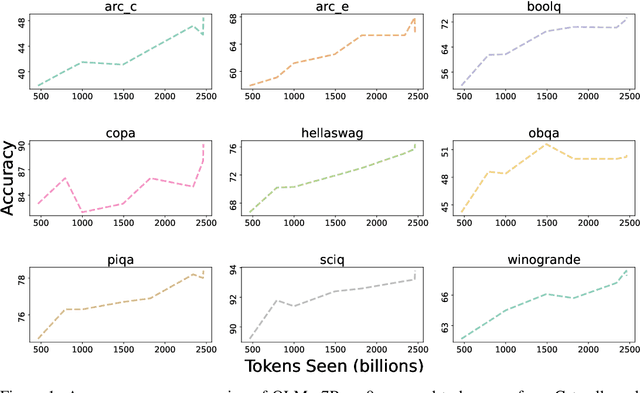
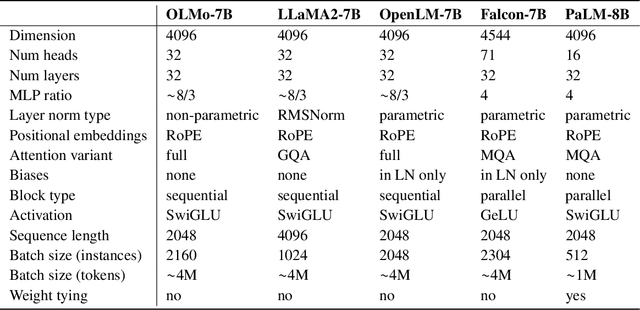
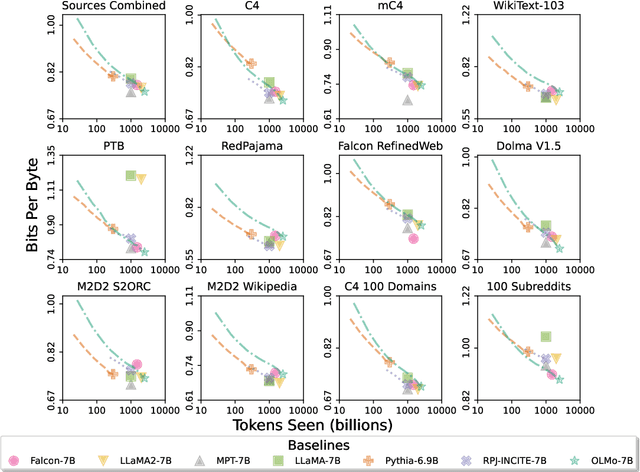
Abstract:Language models (LMs) have become ubiquitous in both NLP research and in commercial product offerings. As their commercial importance has surged, the most powerful models have become closed off, gated behind proprietary interfaces, with important details of their training data, architectures, and development undisclosed. Given the importance of these details in scientifically studying these models, including their biases and potential risks, we believe it is essential for the research community to have access to powerful, truly open LMs. To this end, this technical report details the first release of OLMo, a state-of-the-art, truly Open Language Model and its framework to build and study the science of language modeling. Unlike most prior efforts that have only released model weights and inference code, we release OLMo and the whole framework, including training data and training and evaluation code. We hope this release will empower and strengthen the open research community and inspire a new wave of innovation.
Dolma: an Open Corpus of Three Trillion Tokens for Language Model Pretraining Research
Jan 31, 2024



Abstract:Language models have become a critical technology to tackling a wide range of natural language processing tasks, yet many details about how the best-performing language models were developed are not reported. In particular, information about their pretraining corpora is seldom discussed: commercial language models rarely provide any information about their data; even open models rarely release datasets they are trained on, or an exact recipe to reproduce them. As a result, it is challenging to conduct certain threads of language modeling research, such as understanding how training data impacts model capabilities and shapes their limitations. To facilitate open research on language model pretraining, we release Dolma, a three trillion tokens English corpus, built from a diverse mixture of web content, scientific papers, code, public-domain books, social media, and encyclopedic materials. In addition, we open source our data curation toolkit to enable further experimentation and reproduction of our work. In this report, we document Dolma, including its design principles, details about its construction, and a summary of its contents. We interleave this report with analyses and experimental results from training language models on intermediate states of Dolma to share what we have learned about important data curation practices, including the role of content or quality filters, deduplication, and multi-source mixing. Dolma has been used to train OLMo, a state-of-the-art, open language model and framework designed to build and study the science of language modeling.
Paloma: A Benchmark for Evaluating Language Model Fit
Dec 16, 2023Abstract:Language models (LMs) commonly report perplexity on monolithic data held out from training. Implicitly or explicitly, this data is composed of domains$\unicode{x2013}$varying distributions of language. Rather than assuming perplexity on one distribution extrapolates to others, Perplexity Analysis for Language Model Assessment (Paloma), measures LM fit to 585 text domains, ranging from nytimes.com to r/depression on Reddit. We invite submissions to our benchmark and organize results by comparability based on compliance with guidelines such as removal of benchmark contamination from pretraining. Submissions can also record parameter and training token count to make comparisons of Pareto efficiency for performance as a function of these measures of cost. We populate our benchmark with results from 6 baselines pretrained on popular corpora. In case studies, we demonstrate analyses that are possible with Paloma, such as finding that pretraining without data beyond Common Crawl leads to inconsistent fit to many domains.
Catwalk: A Unified Language Model Evaluation Framework for Many Datasets
Dec 15, 2023Abstract:The success of large language models has shifted the evaluation paradigms in natural language processing (NLP). The community's interest has drifted towards comparing NLP models across many tasks, domains, and datasets, often at an extreme scale. This imposes new engineering challenges: efforts in constructing datasets and models have been fragmented, and their formats and interfaces are incompatible. As a result, it often takes extensive (re)implementation efforts to make fair and controlled comparisons at scale. Catwalk aims to address these issues. Catwalk provides a unified interface to a broad range of existing NLP datasets and models, ranging from both canonical supervised training and fine-tuning, to more modern paradigms like in-context learning. Its carefully-designed abstractions allow for easy extensions to many others. Catwalk substantially lowers the barriers to conducting controlled experiments at scale. For example, we finetuned and evaluated over 64 models on over 86 datasets with a single command, without writing any code. Maintained by the AllenNLP team at the Allen Institute for Artificial Intelligence (AI2), Catwalk is an ongoing open-source effort: https://github.com/allenai/catwalk.
 Add to Chrome
Add to Chrome Add to Firefox
Add to Firefox Add to Edge
Add to Edge